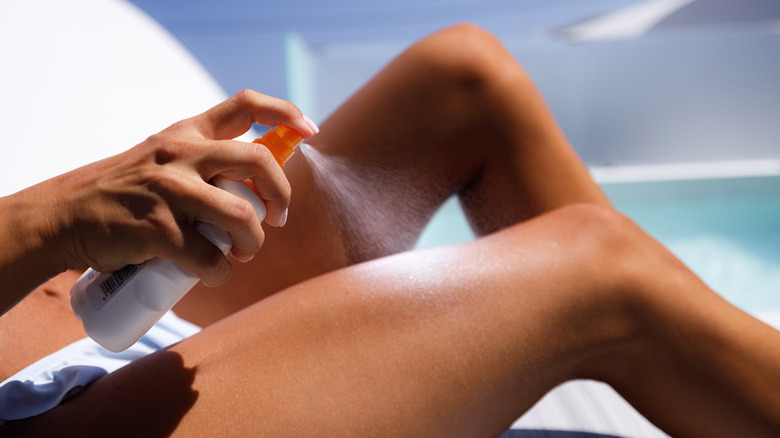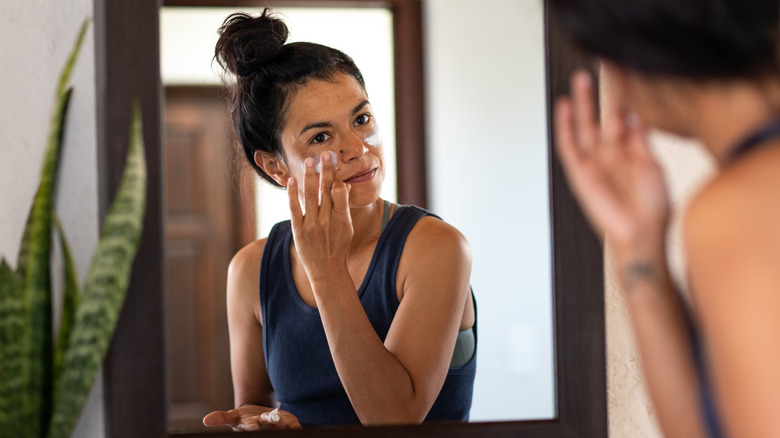The Big Mistake You're Making When Applying Spray-On Sunscreen
When it comes to sunscreen preferences, everyone tends to rely on a specific formula, such as sprays or creams. Spray-on sunscreen is often the popular choice for quick and on-the-go sun protection, and it's common to see people using a spray to protect their skin while on beach vacations and even casual summer outings. Many folks find the aerosol format a more convenient option compared to thick creams and lotions, seeing as you can cover larger areas of the body and sprays tend to feel lighter on the skin.
In general, however, spray-on sunscreens are less reliable in terms of sufficient coverage if you don't know how to use them. For this reason, Glam spoke to board-certified dermatologist Dr. Kelly Aschenbeck from Westlake Dermatology to understand the biggest mistake that people make with an aerosol sunscreen. "Spray sunscreens need to be rubbed in so that there is an even layer of coverage over the skin," Dr. Aschenbeck explains during an exclusive interview with Glam. "If it is not rubbed in, there can be missed areas that are not protected." Uneven coverage doesn't only increase the risk of sunburn, but it also leaves you vulnerable to sun damage, such as sun spots, and even skin cancer. Thankfully, applying your spray-on sunscreen safely and effectively by rubbing it in can prevent skin damage, according to Dr. Aschenbeck.
The best way to use spray-on sunscreen
Many people wonder if you should leave sunscreen to sit on your skin prior to rubbing it in. However, allowing the sunscreen to sit rather than rubbing it in section by section doesn't necessarily increase absorption or effectiveness. In fact, during our exclusive chat with dermatologist Dr. Kelly Aschenbeck, "Rubbing in spray sunscreen immediately will facilitate getting an even layer of coverage while the sunscreen is still spreadable. Applying to one body area at a time (i.e. one arm or one leg) and rubbing in immediately after spraying will help with this."
A 2005 study published in the Journal of the American Academy of Dermatology also found that rubbing in your spray sunscreen immediately after applying will ensure proper coverage. Additionally, when using a spray sunscreen, remember to apply enough product — as in enough to adequately cover the target area — to help prevent blotchy coverage. This also applies for both chemical and mineral sunscreens. Don't assume you can skip proper application simply because your chemical sunscreen won't leave a white cast. You still need to rub the product in fully, as you would with a mineral sunscreen. On that note, if you prefer mineral sunscreens over chemical sunscreens due to ingredient preferences or sensitivities, you'll be relieved to know that spray-on mineral sunscreens are now widely available.
How does spray-on sunscreen compare to creams or lotions?
All forms of sunscreen can be ineffective if you're not applying the product properly, including spray-on sunscreens, says dermatologist Dr. Kelly Aschenbeck. " ... make sure you are using at least an SPF 30, reapplying every two hours, and rubbing in an even layer over all exposed areas," Dr. Aschenbeck advises in our exclusive chat. There are many aerosol sunscreens that claim to have a no-rub formula, but failing to rub the product into your skin results in uneven coverage and leaves you vulnerable to sun damage. If you're concerned about wasting product when aiming for hard-to-reach areas or on windy days, spray your sunscreen directly into the palm of your hand and then apply it to your skin. But if your spray-on sunscreen is labeled at least SPF 30, a comparable amount will be just as effective as creams and lotions provided you apply it evenly and correctly.
Note that applying a mist of SPF setting spray is not enough to protect you from the sun's rays and is not comparable to a standard sunscreen face lotion or spray. A makeup setting spray that contains SPF should always be accompanied by a face lotion underneath or, at the very least, a powder sunscreen on top, if only to increase the defensive coverage as much as you can. However, SPF setting sprays and powder sunscreens do not replace sunscreen face lotion and should not be used as a reliable alternative on their own.


